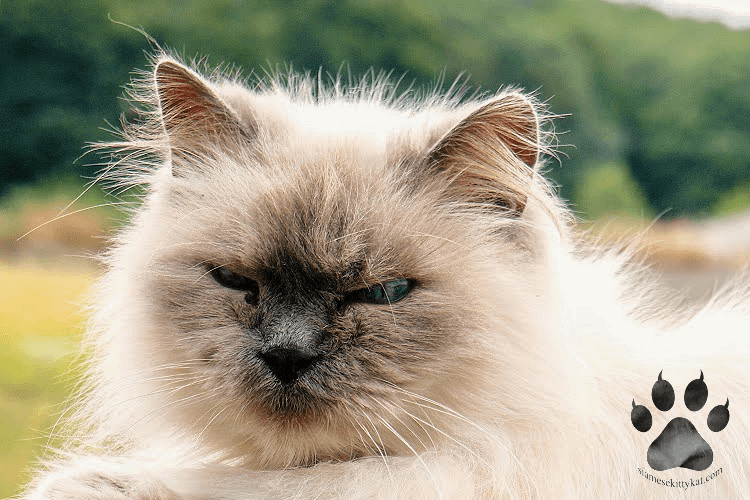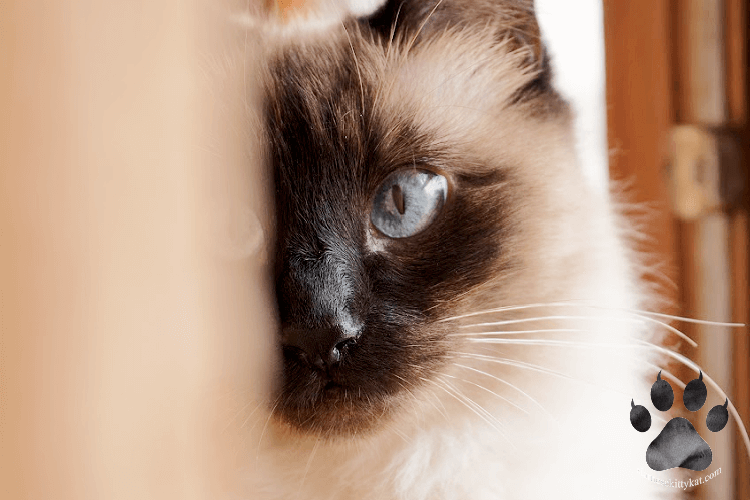Yes, Siamese cats can be fluffy. There are long-haired variants of the breed, famously known as Balinese cats. They have long and fluffy fur. There are crossbreeds between Siamese cats and long-haired cats that can be fluffy.
I had a stunning Balinese cat named Charmin in my twenties. Her fluffy, long-haired coat, dazzling blue eyes, and regal presence made her a sight to behold.
I always thought Charmin knew how gorgeous she was. She was perpetually ready to preen and pose whenever I took a photo of her. What made her more special was her wonderful personality. She was affectionate.
I still fondly remember her even years after she’s gone. Charmin loved to cuddle. She often purred as I stroked her fluffy, soft fur. What I loved most about Charmin was her loyalty. She was a great companion. She was always by my side whenever I was working or relaxing.
Is A Cat’s Fluffiness Determined By Their Breed Or Genetics?
A cat’s fluffiness is mainly due to genetics. The cat’s breed can also impact fluffiness, but genetic factors are the primary reason.
A cat’s age, diet, and grooming practices can also affect his fur quality.
I’d be happy to go through the factors with you one by one.
1. Genetics
Your cat’s fluffiness is largely due to the genes of his parents. Genetics indeed play the top role in determining a cat’s fluffiness.
Your cat’s genes influence his fur’s thickness, length, and texture.
Genes are the fundamental units of heredity that cat parents pass down to their offspring. These genes can be dominant or recessive. They are responsible for the unique differences among cats’ fur.
Some genes are more powerful and can primarily influence how a cat’s fur looks. Other genes are weaker, so their effects are less noticeable.
Your cat is likely to have short hair if both parents pass on recessive genes for short hair.
2. Breed

Your cat’s breed can also affect the fluffiness of his fur. Some cat breeds are naturally born with super thick and fluffy fur, like Maine Coons. Other breeds, like Sphynx, have short, fine fur that we do not consider fluffy.
Some cat breeds have thicker undercoats than others. This undercoat can also contribute to the fluffiness of the cat’s fur. For example, Persian cats have thicker undercoats than Siamese cats.
3. Hair Density
Hair density can also affect the fluffiness of a cat’s fur.
Trivia time! The number of hair follicles in a cat’s skin varies depending on breed.
Siamese cats have thin coats with only 100-200 hair follicles per square inch. Persian cats have a denser coat with up to 700 hair follicles per square inch.
4. Age
The texture of your cat’s fur also changes as he ages.
Your cat’s coat becomes thinner and less dense as he gets older.
Also, you will notice that senior cats often have unkempt fur. This is because they have a more challenging time grooming themselves when they age. This can further affect the quality of their hair.
4. Diet
Your cat’s diet can impact his fur quality. Your cat’s fur has protein. A diet high in protein is essential for maintaining healthy fur growth.
A nutritious diet can prevent common hair issues like dryness and excessive shedding. Feed your cat high-quality commercial cat food.
You can also prepare homemade meals and add fish oil or biotin supplements. Also, give your cat plenty of clean water so he won’t have dry and brittle fur.
5. Grooming Practices
Brushing and bathing can help maintain the health and appearance of your cat’s fur.
Brushing stimulates your cat’s skin. It helps distribute natural oils throughout his fur. Regular brushing can help prevent the matting of your cat’s fur. Matting can cause skin irritation. Regular brushing can also help reduce the likelihood of hairballs.
Bathing removes dirt and dead skin cells from your cat’s fur. Your cat’s fur will look dull and dry if you don’t bathe him for over a month.
Also, you don’t have to bathe your cat too often. Too much bathing could strip your cat’s skin and remove natural oils, leading to dry and irritated fur.
What Environmental Factors Can Affect A Cat’s Fur Quality?

These are the environmental factors that can affect your cat’s fur:
1. Weather
Have you noticed how your cat’s coat changes throughout the year? It’s normal. Your cat is just naturally adapting to the different environmental conditions. The weather and temperature can impact your cat’s fur.
Your cat’s fur may become thicker and fluffier when the weather turns cold. This is your cat’s way of keeping himself warm and cozy. Conversely, your cat’s fur may become thinner when it starts to heat up. Your cat is regulating his body temperature so he can prevent overheating.
2. Sunlight Exposure
Too much sunlight exposure can dry your cat’s fur, make it frizzy, and fade. The UV radiation from the sun can damage the melanin pigment in your cat’s hair.
Also, too much sun exposure can cause sunburn and skin irritation for your cat — the same as it can for us. Limit your cat’s time outside during hot weather.
How Can You Differentiate Between A Fluffy Cat And An Overweight Cat?
A fluffy cat and an overweight cat can look alike. Differentiating the two can be tricky. I’ll share two things you can look for to help distinguish between the two.
1. Movement
A cat with fluffy fur can move as gracefully as a cat without fluffy fur. The cat can climb quickly and jump gracefully despite his fluffy appearance. Meanwhile, an overweight cat tends to move slower. The cat finds it challenging to climb or jump because of the extra weight he carries.
2. Body Shape
A cat with fluffy fur has a more proportional body shape. The cat seems bigger than he is because of his thick hair. On the other hand, an overweight cat has a rounder and more pear-shaped body. The cat has a noticeable layer of fat around his tummy.
Are There Health Risks Associated With Cats That Have Fluffy Coats?
Fluffy cats do not have any health risks associated with their fur. Although, they need some extra grooming to keep their coat from getting matted. Their skin can also get irritated if you do not care for their hair.
Also, cats with long and fluffy hair are more prone to hairballs, which could lead to tummy troubles. Watch out for overheating during hot weather, especially if your fluffy cat is a bit on the heavy side.
Thank you for reading! I hope this blog helps.
Want to immerse yourself more in the captivating world of Siamese cats? I’ve got all the information you need from their distinct color points to their fun personalities: Siamese Cats: Unique Features and Personality

